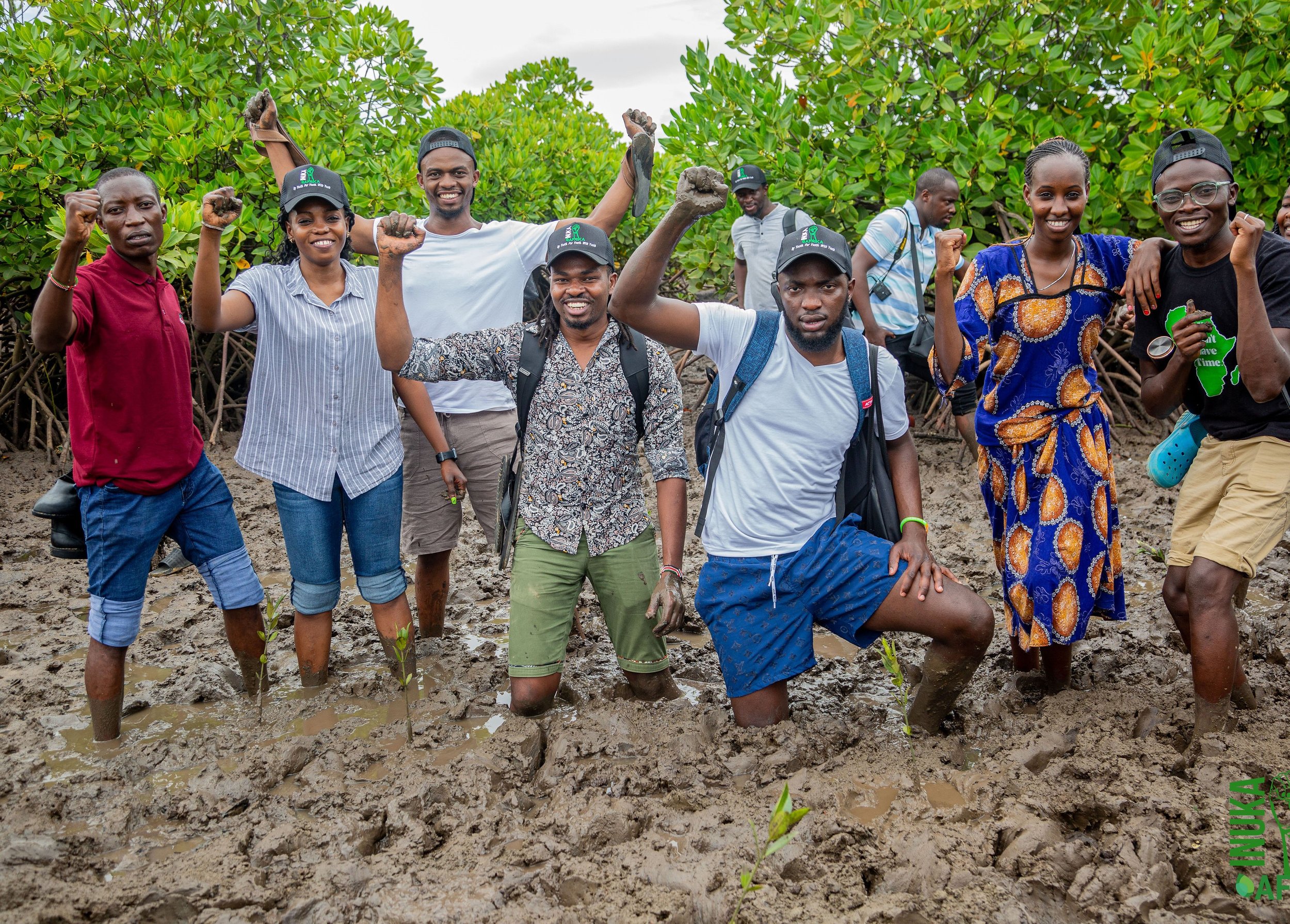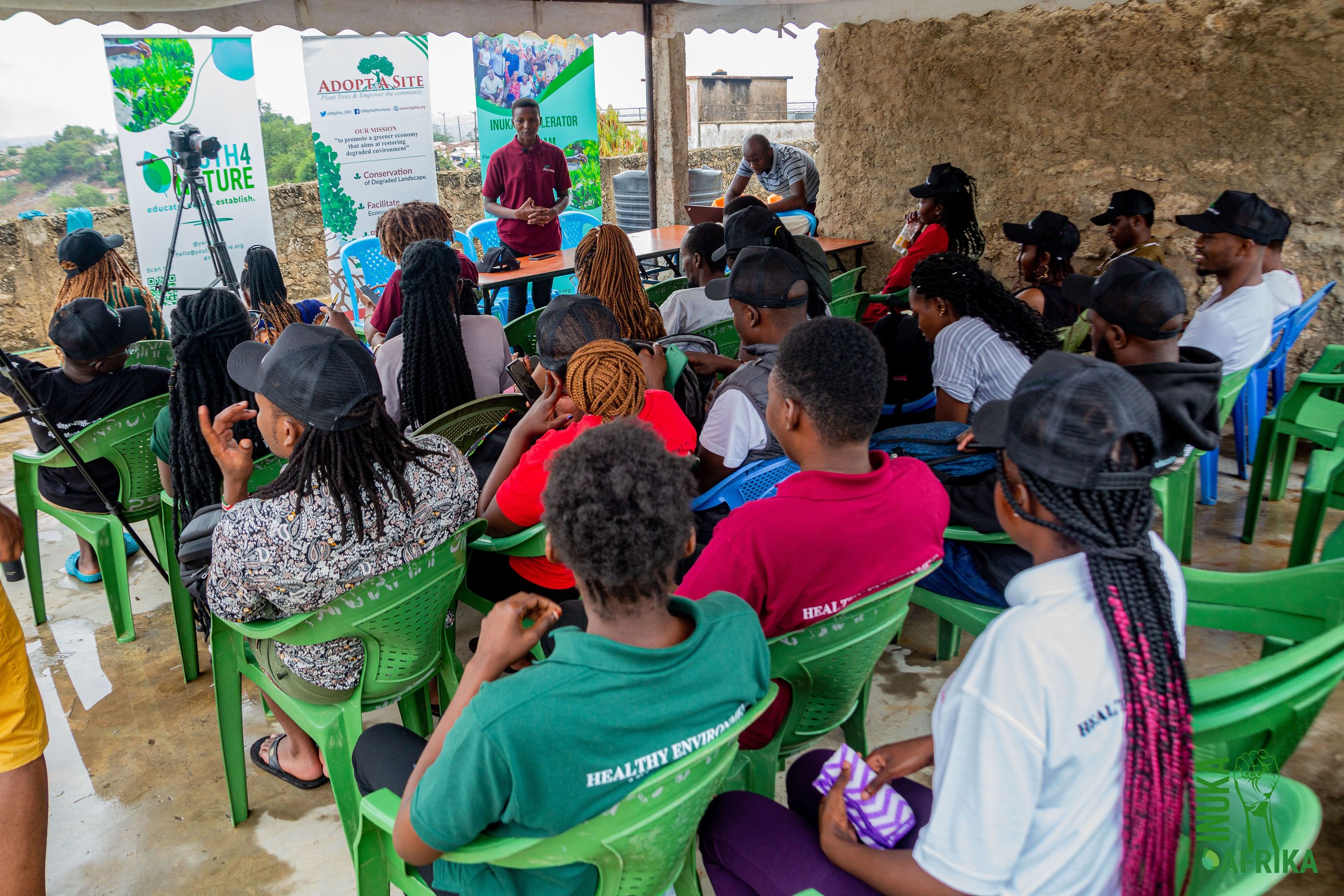(Sustainable Mangroves, an Approach to Nature-Climate Action")
Author(s): Diana Anyoso Big Ship, Peter Bulimo (Youth4Nature- INUKA)
Team members from the Inuka project with volunteers and members from Big Ship after a restoration exercise
Big Ship is a youth-led organisation that focuses on environmental protection through mangrove restoration and conservation. We are among the pioneer youth led organisations in Mombasa County that champions for the restoration of the immensely degraded mangrove forest. We are also one of the youth groups engaged in the INUKA restoration pilot. In our organisation, every mangrove planted is a community empowered. We were deeply honoured to host the first site visit for the INUKA project. During this visit, we had the opportunity to take the team through the breadth and depth of the extensive Tudor creek, in what the INUKA youth described as a "fun learning experience"
Rhizophora mucronata species of Mangroves commonly known as Red mangrove and locally as Mkoko
In restoration, one never gets the real experience until they get hands-on in the field. We had the privilege to host the youth teams at our Big Ship offices, where they explored some of our successfully restored sites, took part in mangrove planting exercise and got first hand experience of what mangrove restoration feels like. Together, we learned and unlearned some of the Nature-based solutions, best practices in mangrove restoration and conservation, and how they integrate with community livelihoods. On the last day, the team was taken on an adventurous learning tour of the creek using canoes to sum up the visit- truly a once in a lifetime experience.
The benefits of mangrove are overarching and cross-cutting, serving both the community and the environment in equal measures. They sequester carbon, shield against floods and provide habitat for aquatic life. Mangroves not only enhance species diversity in the areas they exist, but also improve soil fertility and reduce erosion. Along the Tudor creek, mangrove is the main source of livelihood for adjacent communities who depend on it for income, be it through conservation farming (bee keeping), crab and nursery establishment, fishing or firewood and timber harvesting for domestic and commercial use. Currently, the community is looking at ways of introducing eco-tourism and aquaculture as a lucrative means of livelihood to complement already existing revenue avenues. Though with their own fair of challenges, communities along the Tudor creek have proved that indeed, investing in nature is investing in people.
Avecinia marina commonly known as the white/grey mangrove and locally as Mchuu at the restoration site before the restoration exercise
The Big Ship mangrove tour was an enlightening and educational experience for the youth teams involved. On one hand, they gained an understanding of a community-focused approach to restoration. On the other hand, they learned how such approaches either align or differ with Nature-based Solutions (NbS) best practices courtesy of INUKA's NbS 101 training, which was also offered on-site. Through this experiential learning model, the youth not only familiarise themselves with what works and what doesn't in NbS-focused restoration, they also significantly improved their ability to identify and manage what would otherwise have passed as false solutions. Recognizing the complexities surrounding NbS and its susceptibility to greenwashing and other false solutions, the youth committed to continuous capacity building and knowledge sharing among themselves to remain informed. They also emphasised the need for mentorship to guide them through this restoration journey.
Mangrove Conservation.
Understanding what Big Ship has done in the restoration of Tudor creek in person is much more than you can ever find out by simply researching online. The organisation was formed in 2009 with a mission to promote sustainable development by empowering youths and women in environmental conservation. One of its greatest pillars is marine conservation where it is dealing with mangrove protection, restoration and conservation among others.
In Kenya, the conservation and management of forests is viewed in the context of social and economic development, whose targets are embedded in the country's economic blueprint, Kenya Vision 2030, as well as in the 2010 Constitution. In addition to helping regulate carbon dioxide, mitigate climate change and protect soils and water, forests hold more than three quarters of the world’s biodiversity, provide many products and services that contribute to socio-economic development, mangrove is not an exception.
Information and knowledge sharing session between the Inuka team, Big Ship and members of the community
Over the years mangroves of Tudor creek have faced serious threats associated with extensive pollution, and human induced degradation (logging, fuel wood, timber and poles) which in turn has created negative impacts on the marine habitat and to community livelihoods. To curb this Big Ship adopted a unique model known as adopt a site.
Adopt A Site
It is a restoration project model designed to facilitate tree planting for community development through looking for partners both from public and private sectors to invest in increasing forest cover and promote decent work and economic growth. This applies to both mangrove and terrestrial conservation. It applies a four phase approach that promotes sustainable restoration through; 1) Mapping of degraded sites (2) Community partnership (3) Restoration (4) Socio Economic Development which is the Investment arm.
Ceriops tagal species growing at one of the adopted sites. The species is commonly known as the Yellow mangrove and locally as Mkandaa
Through this model, Big Ship has restored 60.9 ha of degraded mangrove areas and is working with 8 community groups along the creek. The INUKA Team got to adopt a site that saw a planting of 50 mangrove seedlings of species of Rhizophora mucronata and 50 propagules commemorating the International Day of Forests that happened on 21st of March 2023.
Mangroves Species of Tudor creek
For restoration activities, Big Ship is currently focused on restoring three mangrove species namely Rhizophora mucronata which is a fast growing tree and good for soil formation, Bruguiera ghymnorrhizer known to attract bees that helps in apiculture and Ceriops tagal due it its adaptability to survive in very harsh substrates. The three species also reproduce vegetatively and their seeds are easier to propagate for scale up.
Monitoring
The monitoring plan is designed to ensure 100% success rate to trees planted through understanding the scientific ecological mangrove patterns, community indigenous knowledge and use of Geographic Information System (GIS). The following activities are conducted to ensure this success:
1. Site assessment and mapping
2. Quality seedlings mobilizations to ensure planted seedlings are mature.
3. Supervision of activity by the local scouts.
4. Periodic monitoring conducted at three,, six and 18 months intervals and reporting on planted trees to check survival, growth rate and disturbances.
Bruguiera gymnorrhiza commonly known Orange mangrove and locally as Muia/Mkoko Mwembe
Xylocarpus granatum commonly known as Cannonball mangrove and locally as Mkomafi at one of the adopted sites
Challenges facing the Mangrove Ecosystem
Tudor creek is listed nationally among the highly degraded peri-urban mangrove ecosystems due to human induced factors. Harvesting of wood for fuel and timber as mangrove is cheap, strong and durable for building materials, land-encroachment due to rising infrastructure and development have led to overpopulation along the mangrove, the mangrove peripheral zone. Additionally, extensive logging and pollution caused by the poor drainage systems in the past three decades has been increasing demand for the mangrove resources.
Livelihood Options
Big Ship is committed to providing alternative sources of livelihood to the community within through involving them in the mangrove planting as labourers, purchasing seedlings from them, offering free financial literacy trainings, training them on nursery establishment, beekeeping and offering a market for the honey harvested, aquaculture and employing some as local scouts.
Working with INUKA
Being a pilot programme that aims to accelerate youth led Nature-based Solutions projects across Kenya, INUKA has so far trained the group on NbS, offered learning modules and is also aimed at increasing the group capacity through storytelling so as they get to share their untold on-the-ground actions, proposal writing for grant seeking, networking with experts (trainers and mentors),and promoting youth entrepreneurial skills. This will help Big Ship and other groups in scaling up their project areas and being able to make informed decisions on matters of nature derived and nature inspired solutions.
Conclusion
An ocean without mangrove is like a tree without roots! Mangroves are the ocean lungs supporting both lives at sea and on land, we therefore call upon you to adopt a site at Big Ship CBO and help our ocean, help our future generation. AFRIKA RISING!
This blog was curated by the Inuka project partners Big Ship implementing NbS projects at the Coast of Kenya in Mombasa.








